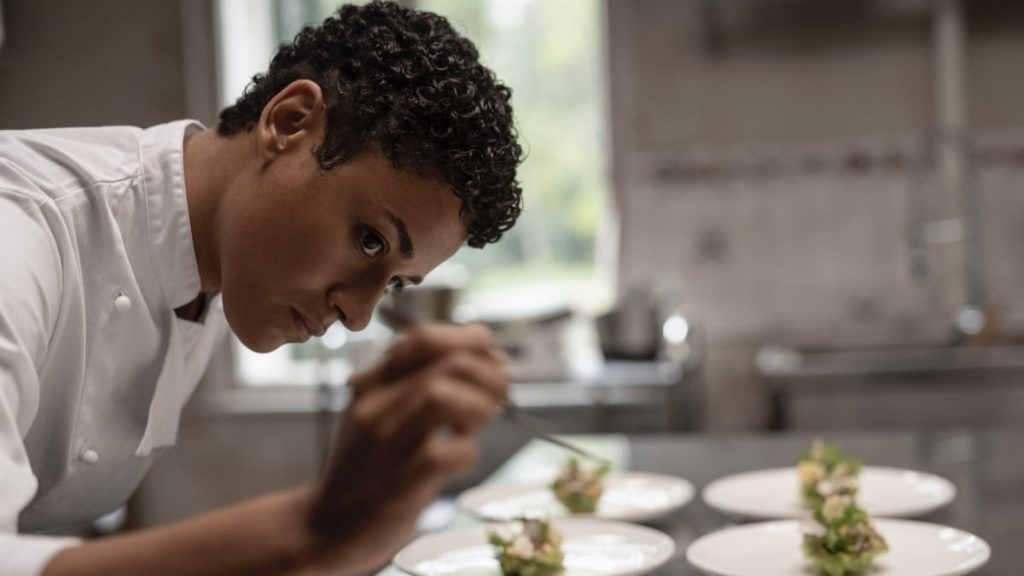“To be a chef, you’ve got to love the taste of blood.”
So says one of the many chefs present in House of Spoils, and writers and directors Bridget Savage Cole and Danielle Krudy (Blow the Man Down) are all too happy to oblige. Right from the jump, blood and cooking are intertwined. In the film’s opening, a coven of women gather around a fire, pounding what looks like hunks of bloody flesh into a paste. Cut to equally bloody filets on the grill in a high-end Manhattan kitchen. Cooking, it seems, is its own kind of witchcraft — and House of Spoils is ready to serve us a thrilling five-course meal of both.
What’s House of Spoils about?

Ariana DeBose in “House of Spoils.”
Credit: Courtesy of Prime
A dark fairy tale with culinary bite, House of Spoils dives into one chef’s pursuit of perfection, a theme viewers might most recently associate with The Bear or The Menu. But make no mistake, House of Spoils‘ similarities to those projects start and end with the fact that they take place in a high-end restaurant.
The chef in question has no name. She’s just Chef (Ariana DeBose, West Side Story), her sense of self so tied to her profession that there’s no room for anything else. She gets the chance of a lifetime when she partners with smarmy restaurateur Andreas (Arian Moayed, Succession) on a rural restaurant upstate.
Covered in ivy and boasting a secret garden, Chef’s new restaurant is straight out of a storybook, the magical launchpad for her greatest dream. Yet something is off. Namely, the food. Bugs squirm their way into her every dish, and mold overtakes her ingredients faster than biologically possible. Is this just some run-of-the-mill infestation? Or is it a curse from the property’s previous owner, widely rumored to be a witch?
Mashable Top Stories
House of Spoils wrings spooks and inspiration from mold and decay.

Ariana DeBose in “House of Spoils.”
Credit: Courtesy of Prime
Although it boasts its fair share of jump scares and ghostly figures lurking in the background, House of Spoils‘ true horror lies in its food. The sight of bugs crawling just below the surface of a dish calls to mind parasites wriggling below the skin of a host, and the thick blankets of mold-draped food are a surefire way to induce nausea.
But perhaps the most disturbing element of the restaurant’s mysterious curse is how quickly it erases Chef’s hard-earned work. Decay decimates an entire night of peaceful cooking prep, throwing a make-or-break meeting with an investor in disarray. Seeing Chef’s plans fall apart time and time again, both by supernatural reasons and human doubt from Andreas, elicits more dread than even the spookiest jump scare. (Although those certainly help accentuate the pain!)
Yet House of Spoils finds a flip side in the challenges Chef faces. When she discovers the prior owner’s secret garden, Chef embarks on a foraging journey for the ages, with she and her sous chef, Lucia (Barbie Ferreira, Euphoria), finding a way to turn discarded plants and even mold and bugs into fine-dining gold. Food stylist Zoe Hegedus crafts concoctions that are as alluring as they are repelling, such as a funky mold-tinged bread and a mushroom dish that Chef encourages people to eat without any silverware. Chef’s near-possession by culinary inspiration (or maybe something more?) is intoxicating, with Cole and Krudy luring viewers into a lush yet unsettling world of cooking.
House of Spoils tackles toxic masculinity in the cooking world.

Ariana DeBose and Barbie Ferreria in “House of Spoils.”
Credit: Glodi Balazs / Prime
House of Spoils juxtaposes the lush world Chef enters with the cold, hyper-masculine cooking world she came from originally. It was her mentor and former boss Marcello (Marton Csokas) who made that claim about chefs tasting blood. He also asserted that cooking takes balls, a kind of masculinity Chef tries to emulate in her interactions with her co-workers, much to Lucia’s disapproval. The sous chef describes fine dining as a “big swinging dick club” and decries some of Chef’s “macho posturing.” Contrast that with Chef’s new gardening focus, which she and Andreas describe as “wild, feminine.” In leaving the highly masculine world of her former workplace behind, is Chef discovering and embracing a new part of herself, one she didn’t cultivate in favor of molding herself to the standards of other big shot male chefs?
Complicating matters here is the figure of the witch, who looms over Chef’s dreams with an ominous command: “Feed the soil.” That, coupled with the bloody, sacrificial vibes of the opening sequence, doesn’t paint the most favorable portrait of her approach to cooking either. Is Chef truly transforming and evolving at her craft, or is she being manipulated by higher forces? And are blood and sacrifice truly the only way to approach cooking — or any form of art — in order to find success?
House of Spoils certainly keeps you guessing on that front, and on the role of the witch in general. But trust me when I say you won’t expect House of Spoils‘s final course, a turn of events that eschews what you might expect from a more lurid psychological thriller — again, this isn’t The Menu — in favor of something more quietly rewarding, yet no less filling.
Topics
Amazon Prime Video
Film


